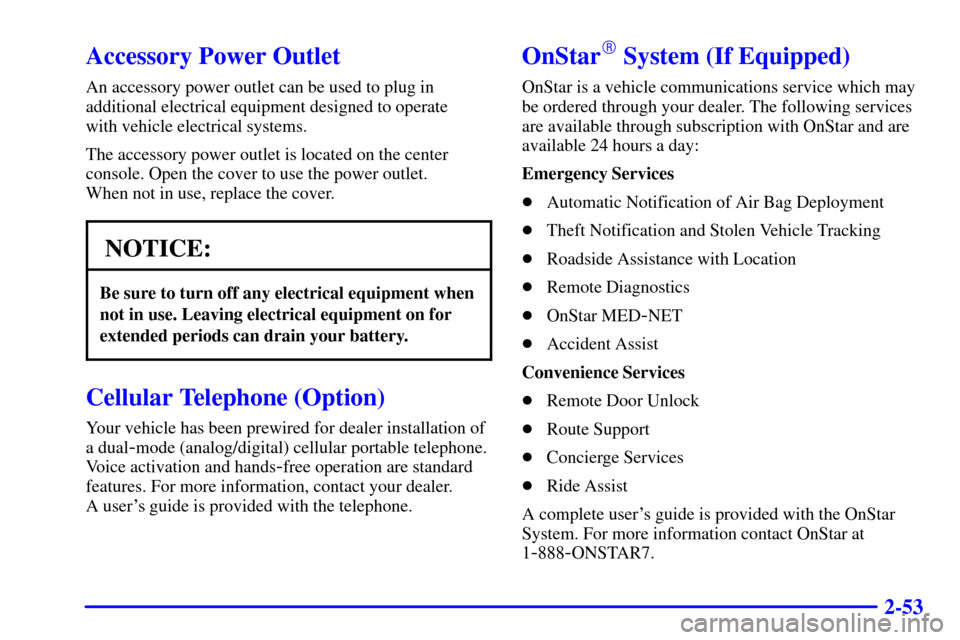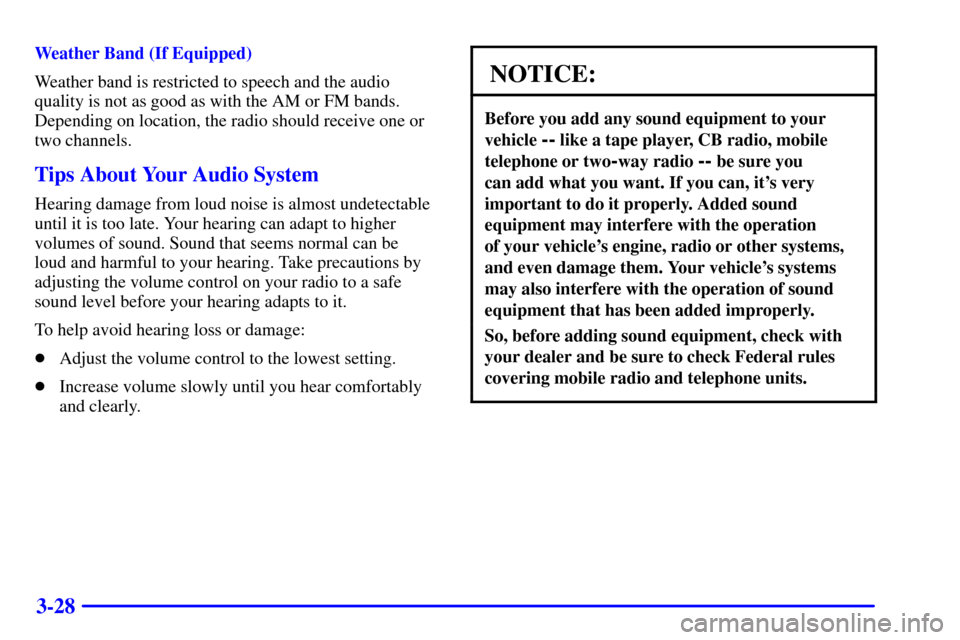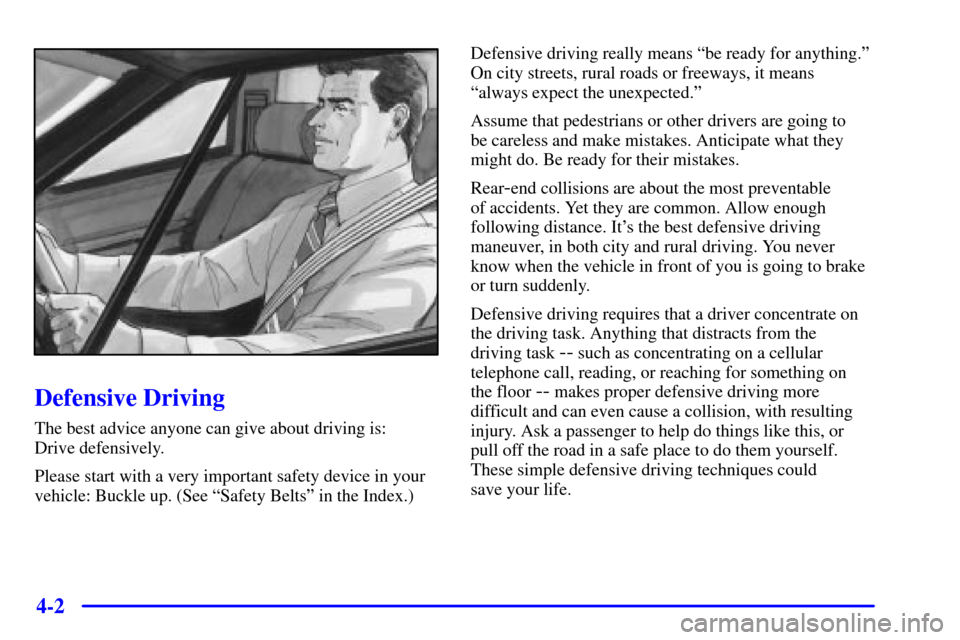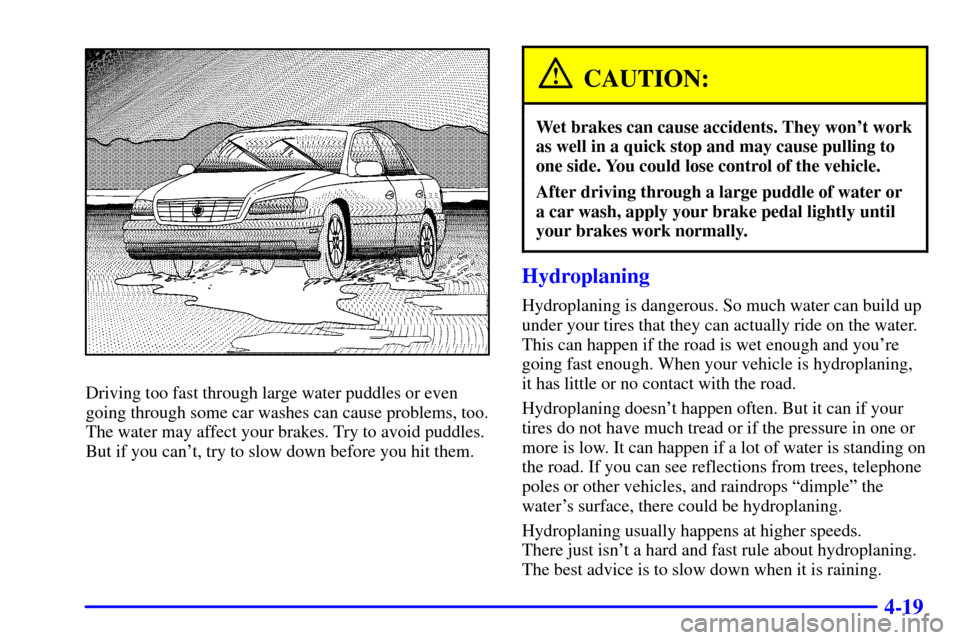Page 82 of 321

2-17
With the key in the
ignition switch, you can
turn the switch to four
different positions.
LOCK (�): Before you put the key in, the ignition
will be in LOCK. This is the only position from which
you can remove the key. This position locks the
ignition, steering wheel and transmission. It's a
theft
-deterrent feature.
OFF (I): This position lets you turn off the engine
but still turn the steering wheel. It doesn't lock the
steering wheel like LOCK. Use OFF if you must
have your vehicle in motion while the engine is off
(for example, if your vehicle is being pushed).ON (II): The ignition is on in this position. ON is used
for driving your vehicle.
START (III): This position starts the engine.
To lock the steering column, remove the key while in
LOCK. Turn the steering wheel until you hear a click.
Retained Accessory Power (RAP)
The radio and the optional cellular phone are the only
accessories on your vehicle that may be used for up to
10 minutes after the ignition is turned to OFF or until
a door is opened.
Power to the door locks is available at all times. Power
to the fuel door and trunk release will be available
for 15 minutes after the ignition is turned to OFF.
The power window controls and the sunroof (optional)
controls are active until a door is opened
-- there is
no time limit as long as the doors remain closed.
Page 118 of 321

2-53
Accessory Power Outlet
An accessory power outlet can be used to plug in
additional electrical equipment designed to operate
with vehicle electrical systems.
The accessory power outlet is located on the center
console. Open the cover to use the power outlet.
When not in use, replace the cover.
NOTICE:
Be sure to turn off any electrical equipment when
not in use. Leaving electrical equipment on for
extended periods can drain your battery.
Cellular Telephone (Option)
Your vehicle has been prewired for dealer installation of
a dual
-mode (analog/digital) cellular portable telephone.
Voice activation and hands
-free operation are standard
features. For more information, contact your dealer.
A user's guide is provided with the telephone.
OnStar� System (If Equipped)
OnStar is a vehicle communications service which may
be ordered through your dealer. The following services
are available through subscription with OnStar and are
available 24 hours a day:
Emergency Services
�Automatic Notification of Air Bag Deployment
�Theft Notification and Stolen Vehicle Tracking
�Roadside Assistance with Location
�Remote Diagnostics
�OnStar MED
-NET
�Accident Assist
Convenience Services
�Remote Door Unlock
�Route Support
�Concierge Services
�Ride Assist
A complete user's guide is provided with the OnStar
System. For more information contact OnStar at
1
-888-ONSTAR7.
Page 172 of 321

3-28
Weather Band (If Equipped)
Weather band is restricted to speech and the audio
quality is not as good as with the AM or FM bands.
Depending on location, the radio should receive one or
two channels.
Tips About Your Audio System
Hearing damage from loud noise is almost undetectable
until it is too late. Your hearing can adapt to higher
volumes of sound. Sound that seems normal can be
loud and harmful to your hearing. Take precautions by
adjusting the volume control on your radio to a safe
sound level before your hearing adapts to it.
To help avoid hearing loss or damage:
�Adjust the volume control to the lowest setting.
�Increase volume slowly until you hear comfortably
and clearly.
NOTICE:
Before you add any sound equipment to your
vehicle
-- like a tape player, CB radio, mobile
telephone or two
-way radio -- be sure you
can add what you want. If you can, it's very
important to do it properly. Added sound
equipment may interfere with the operation
of your vehicle's engine, radio or other systems,
and even damage them. Your vehicle's systems
may also interfere with the operation of sound
equipment that has been added improperly.
So, before adding sound equipment, check with
your dealer and be sure to check Federal rules
covering mobile radio and telephone units.
Page 175 of 321

3-31 Heated Backlite Antenna
Your AM-FM antenna is integrated with your
rear window defogger, located in the rear window.
Be sure that the inside surface of the rear window is
not scratched and that the lines on the glass are not
damaged. If the inside surface is damaged, it could
interfere with radio reception.
NOTICE:
Do not try to clear frost or other material from
the inside of the rear window with a razor blade
or anything else that is sharp. This may damage
the rear defogger grid and affect your radio's
ability to pick up stations clearly. The repairs
wouldn't be covered by your warranty.
If, when you turn on your rear window defogger, you
hear static on your radio station, it could mean that a
defogger grid line has been damaged. If this is true,
the grid line must be repaired.
If you choose to add a cellular telephone to your vehicle,
and the antenna needs to be attached to the glass, be sure
that you do not damage the grid lines for the AM
-FM
antenna. Be sure the antenna does not touch a grid line.
Page 177 of 321

4-2
Defensive Driving
The best advice anyone can give about driving is:
Drive defensively.
Please start with a very important safety device in your
vehicle: Buckle up. (See ªSafety Beltsº in the Index.)Defensive driving really means ªbe ready for anything.º
On city streets, rural roads or freeways, it means
ªalways expect the unexpected.º
Assume that pedestrians or other drivers are going to
be careless and make mistakes. Anticipate what they
might do. Be ready for their mistakes.
Rear
-end collisions are about the most preventable
of accidents. Yet they are common. Allow enough
following distance. It's the best defensive driving
maneuver, in both city and rural driving. You never
know when the vehicle in front of you is going to brake
or turn suddenly.
Defensive driving requires that a driver concentrate on
the driving task. Anything that distracts from the
driving task
-- such as concentrating on a cellular
telephone call, reading, or reaching for something on
the floor
-- makes proper defensive driving more
difficult and can even cause a collision, with resulting
injury. Ask a passenger to help do things like this, or
pull off the road in a safe place to do them yourself.
These simple defensive driving techniques could
save your life.
Page 194 of 321

4-19
Driving too fast through large water puddles or even
going through some car washes can cause problems, too.
The water may affect your brakes. Try to avoid puddles.
But if you can't, try to slow down before you hit them.
CAUTION:
Wet brakes can cause accidents. They won't work
as well in a quick stop and may cause pulling to
one side. You could lose control of the vehicle.
After driving through a large puddle of water or
a car wash, apply your brake pedal lightly until
your brakes work normally.
Hydroplaning
Hydroplaning is dangerous. So much water can build up
under your tires that they can actually ride on the water.
This can happen if the road is wet enough and you're
going fast enough. When your vehicle is hydroplaning,
it has little or no contact with the road.
Hydroplaning doesn't happen often. But it can if your
tires do not have much tread or if the pressure in one or
more is low. It can happen if a lot of water is standing on
the road. If you can see reflections from trees, telephone
poles or other vehicles, and raindrops ªdimpleº the
water's surface, there could be hydroplaning.
Hydroplaning usually happens at higher speeds.
There just isn't a hard and fast rule about hydroplaning.
The best advice is to slow down when it is raining.
Page 303 of 321

6-59
Fuse Usage
4 RH and LH Rear Seat Cushion Heater
Relay, Rear Sunshade Motor, Accessory
Power Outlet
5 Transmission Control Module
6 Radio Speaker Amplifier
7 RH and LH Rear Side Door Window
Regulator Motor
8 Headlamp Switch, Turn Signal
Switch, Horn Relay, CD Changer,
Multifunction Relay
9 Windshield Wiper Motor and Relay,
Windshield Wiper and Windshield
Washer Switch
10 Body Control Module (BCM), Heater
Water Auxiliary Pump, Fan Control
Relays, Auxiliary Water Pump Relay
11 Heater and A/C Control, RH and LH
Outside Rearview Mirrors
12 Hazard Warning Switch, Instrument
Cluster, Data Link Connector (DLC),
Stoplamp Switch, Gage Cluster, Heater
and A/C Control.Fuse Usage
13 Remote Control Outside Rearview Mirror
Switch, A/C Compressor Relay, Coolant
Fan Test Connector, A/C Load Switch
14 Cellular Telephone, RH and
LH Windshield Washer Nozzles,
Driver and Passenger Heated Seat Switch,
Heater and A/C Control, Heated Outside
Rearview Mirror and Rear Window
Defogger Relay
15 Rear Suspension Leveling Air Compressor
Relay, Instrument Cluster, Gage Cluster,
Cruise Control Switch, Headlamp Switch,
Multifunction Relay, Passenger and
Driver Heated Seat Relay, BCM, Sunroof
Actuator, Automatic Level Control Sensor,
RH and LH Heated Rear Seat Switch, RH
and LH Heated Rear Seat Cushion Relay,
Driver Seat Adjuster Memory Module,
LH Front Side Door Window Switch,
Inside Rearview Mirror
16 Cigarette Lighter (Front and Console)
17 Horn #1 and #2
18 Fuel Pump
Page 309 of 321
7-
7-1
Section 7 Customer Assistance Information
Here you will find out how to contact Cadillac if you need assistance. This section also tells you how to obtain service
publications and how to report any safety defects.
7
-2 Customer Satisfaction Procedure
7
-3 Customer Assistance for Text Telephone
(TTY) Users
7
-4 Customer Assistance Offices
7
-5 GM Mobility Program for Persons
with Disabilities
7
-5 Roadside Service
7
-7 Roadside Service for the Hearing or
Speech Impaired
7
-8 Courtesy Transportation
7
-8 Transportation Options7
-10 Warranty Information
7
-10 Reporting Safety Defects to the United
States Government
7
-11 Reporting Safety Defects to the
Canadian Government
7
-11 Reporting Safety Defects to General Motors
7
-11 Ordering Owner Publications in Canada